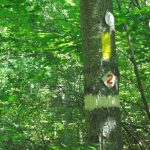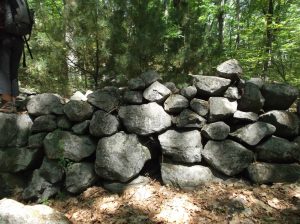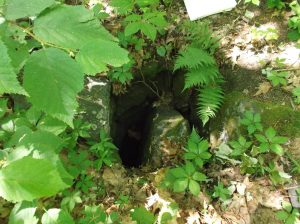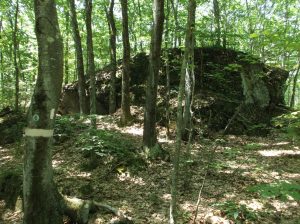 MassLIFT Regional Conservation Coordinator Sarah Brodeur, together with Opacum Land Trust Director Ed Hood and members of the Palmer Trails Committee, led about a dozen of us on a two mile hike through parts of the Shaw Historical District on this lovely summer morning. We met at 10 am at the end of Rondeau Road, then started hiking along the White Trail, on the east side of Pattaquattic Hill. We were each given a map of the area prepared by the Trails Committee, but it was almost unnecessary, as the trail we followed is very well blazed; navigation points are numbered and clearly marked, and points of historical interest are also indicated.
MassLIFT Regional Conservation Coordinator Sarah Brodeur, together with Opacum Land Trust Director Ed Hood and members of the Palmer Trails Committee, led about a dozen of us on a two mile hike through parts of the Shaw Historical District on this lovely summer morning. We met at 10 am at the end of Rondeau Road, then started hiking along the White Trail, on the east side of Pattaquattic Hill. We were each given a map of the area prepared by the Trails Committee, but it was almost unnecessary, as the trail we followed is very well blazed; navigation points are numbered and clearly marked, and points of historical interest are also indicated.
Settlers arrived in Palmer in the early 1700s, although it was not incorporated as a town until after 1750. A man named John King is considered the town’s founding father; he built his first home on the banks of the Quaboag River in 1716, so yes, this year is the 300th anniversary of that event. I was interested to hear that many of the first settlers in Palmer, probably of Scotch-Irish descent, were actually squatters; they did not have deeds to the lands they homesteaded, which is why the settlement’s first petition to the General Court in 1732 to become a town was denied. Here are some observations about the area which I remember from the walk.
- Conservation land in Palmer is currently under a patchwork of ownership
- The Commonwealth owns around 650 acres
- Interesting finds today included fresh bear scat and a geocache location
- The top of Pattaquattic Hill is privately owned; remains of a rock quarry are still visible
- The William Brown family owned a pig farm at this location

- Further along the trail we came upon a second Brown homestead, with a hand-dug well

- Brothers Matthew and Robert Brown were recluses who lived at the end of the road
- It was known that they kept a good deal of money hidden in their home
- Eventually, due to the persistence of thieves, they transferred it to a local bank for safety
- When in 1900 the brothers passed on at ages 89 and 90, they left a large estate
- Captain Kidd’s Rock has a fascinating naming story due to a find near the rock

- In 1849, two boys chasing a rabbit discovered a letter purportedly written by Captain Kidd
- In 1700, it had been lost under the rock by a courier traveling from Boston to New York City
- Legend has it that Captain Kidd buried treasure on Conant Island in Boston Harbor
- That land has since been paved over by one of the Logan Airport runways
- The Shaw District Schoolhouse #2 was built in 1870
- For 20 years, 93 families sent their children to school there
- Trails on this conservation land are sometimes used for mountain bike races
Our destination this morning was Captain Kidd’s Rock and the old Tavern site; when we reached it shortly after noon, about the half group chose to continue the White Trail Loop back to where we started. Sarah and Ed ferried the rest of us back to our cars. We all enjoyed spending the morning walking in these woods and learning about Palmer’s past.